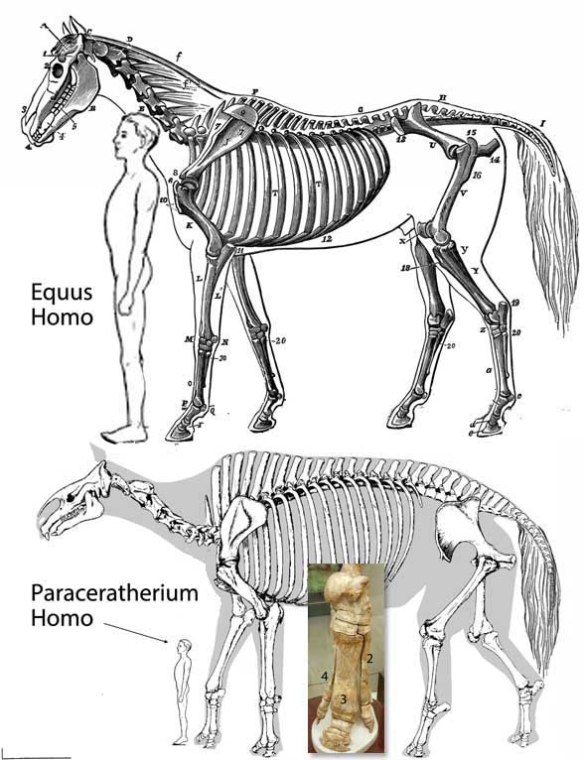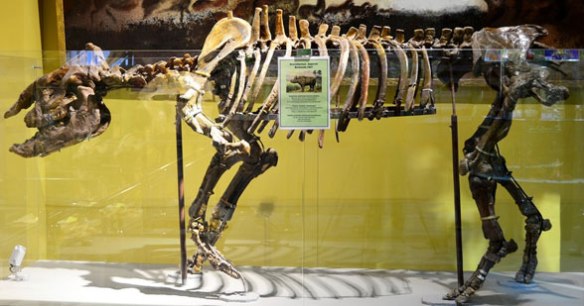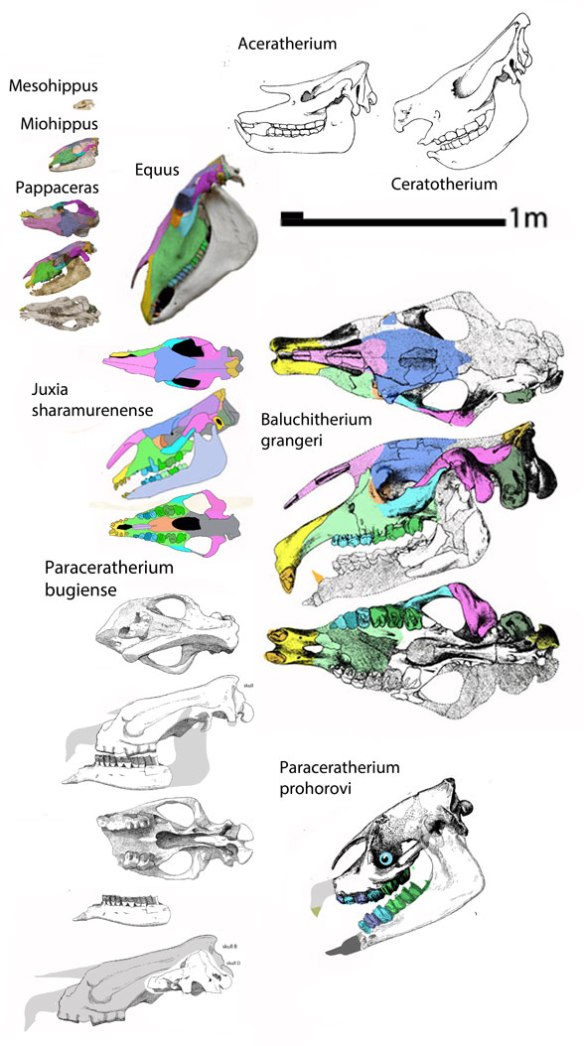Aceratherium is a hornless rhino (Figs 2-4).
Paraceratherium is a GIANT hornless horse (Fig. 1). Even so, the two are similar enough that that latter was named for the former. Thereafter Paraceratherium became known as a rhino.

Figure 1. Equus the horse shares many traits with Paraceratherium, the giant three-toed horse.
However,
and as we learned earlier by testing prior assumptions in the large reptile tree (LRT, 1318 taxa, subset Fig. 5), Aceratherium nested between rhinos and brontotheres. Paraceratherium nested with other large three-toed horses.

Fig. 2 Aceratherium skeletal mount. This hornless rhino is transitional to brontotheres, not indricotheres (= paraceratheres) in the LRT.
Even so,
the convergence is impressive! No wonder earlier workers named the one for the other.

Figure 3. Aceratherium acutum skull drawing and fossil.
Convergence is rampant within the LRT.
For example, we’ve seen mysticetes and odontocetes converge so much we call them all ‘whales’ or ‘cetaceans‘, two terms that need to be dumped in favor of something more in keeping with their phylogenetic nestings. The same has happened with Aceratherium and Paraceratherium. The details of their skeletal traits distinguish them. You can examine those traits in a MacClade file by request.

Figure 4. Indricothere skulls to scale along with horse and rhino skulls.
Perhaps this is just one more instance of paleontology
turning a blind eye toward testing a wider gamut of taxa to validate prior hypotheses… or invalidate them. That’s why the LRT is here: to test prior hypotheses.

Figure 5. Various ungulates and kin subset of the LRT. Here Aceratherium, a hornless rhino, does not nest with Paraceratherium, a giant three-toed horse.
Shifting all the paraceratheres
over to the aceratheres adds 21 steps to the LRT.
Aceratherium incisivum (Kaup 1832; originally Rhinoceros incisivum, Cuvier 1822; Miocene; 2.3m long) nests with short-legged Metamynodon and shares with it long anterior dentary teeth, a straight jugal and a short nasal. Aceratherium lacks an upper canine.

Figure 6. GIF movie (3 frames) showing what is known of the skeletons of Baluchitherium and Indricotherium. Note the more horse-like morphology.
Paraceratherium transouralicum (P. bugtiense holotype, Pilgrim 1908; Baluchitherium, Osborn 1923; late Oligocene, 34-23mya; 4.8m shoulder height, 7.4m long) was long considered a giant hornless rhinoceros, but here nests with the horse, Equus. They share a long neck, straight ventral dentary and the retention of premaxillary teeth, among other traits. Paraceratherium retains three toes, as in ancestral horse/rhinos like Heptodon and Hyracotherium.

Figure 7. Mesohippus, the last common ancestor in the LRT to horses and indricotheres.
References
Chow M and Chiu C-S 1964. An Eocene giant rhinoceros. Vertebrata Palasiatica, 1964 (8): 264–268.
Cuvier G 1822a. Recherches sur les ossements fossiles. Tome second, G. Doufor et d’Ocagne éd., Paris, – (1822b). Tome troisième, – (1824). Tome cinquième.
Forster-Cooper C 1911. LXXVIII.—Paraceratherium bugtiense, a new genus of Rhinocerotidae from the Bugti Hills of Baluchistan.—Preliminary notice. Annals and Magazine of Natural History Series 8. 8 (48): 711–716. doi
Forster-Cooper C 1924. On the skull and dentition of Paraceratherium bugtiense: A genus of aberrant rhinoceroses from the Lower Miocene Deposits of Dera Bugti. Philosophical Transactions of the Royal Society B: Biological Sciences. 212 (391–401): 369–394.
Granger W and Gregory WK 1935. A revised restoration of the skeleton of Baluchitherium, gigantic fossil rhinoceros of Central Asia. American Museum Novitates. 787: 1–3.
Kaup J 1832. Über Rhinoceros incisivus Cuv., und eine neue Art, Rhinoceros schleier-macheri, Isis von Oken, Jahrgang1832 (8: 898-904.
Lucas SG and Sobus JC 1989. The Systematics of Indricotheres”. In Prothero DR and Schoch RM eds. The Evolution of Perissodactyls. New York, New York & Oxford, England: Oxford University Press: 358–378. ISBN 978-0-19-506039-3.
Osborn HF 1923. Baluchitherium grangeri, a giant hornless rhinoceros from Mongolia. American Museum Novitates. 78: 1–15. PDF
Pilgrim GE 1910. Notices of new mammalian genera and species from the Tertiaries of India. Records of the Geological Survey of India. 40 (1): 63–71.
Wood HE 1963. A primitive rhinoceros from the Late Eocene of Mongolia. American Museum Novitates 2146:1-11.
wiki/Juxia
wiki/Paraceratherium
wki/Indricotheriinae
wiki/Metamynodon
wiki/Aceratherium
